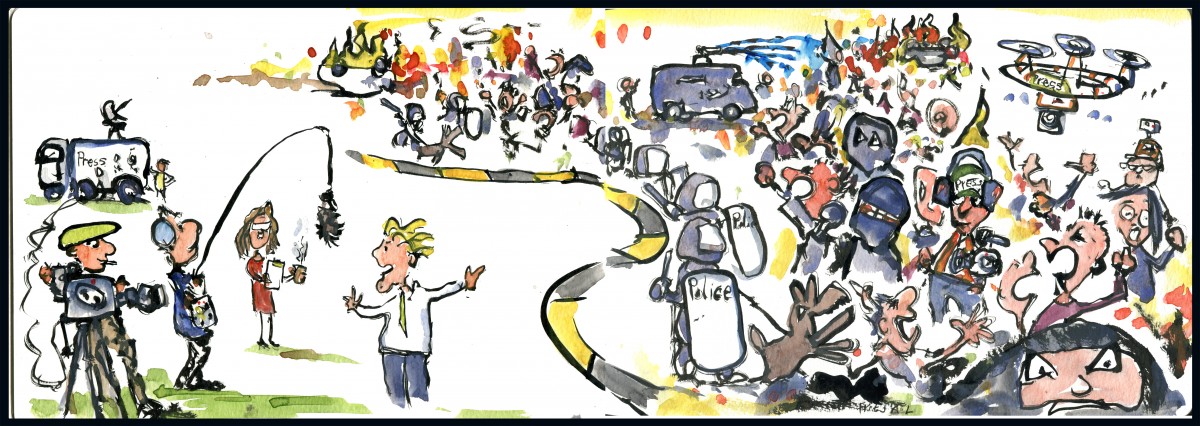The original version of this piece was first published on Devex.com.

Why we all need to ask: Who's doing it better?
“Because the problems scream, but the solutions whisper, we often overlook them,” - David Bornstein, cofounder of the Solutions Journalism Network.
My first international trip for Devex was last fall: I went to Haiti, where I saw how nonstop negative media coverage can lead people to conclude that an entire country is a lost cause. But if you look past the problems that scream, you can find those diamonds in the rough, those whispers of recovery and resilience that rarely make the headlines.
Evidence from the Engaging News Project at the University of Texas suggests that when people think something can be done about a problem, they are more receptive and attentive to that information. The majority of people who read solutions-oriented reporting say that the stories change the way they think about topics and make them feel more inspired and optimistic.
Across the development community, there is a growing push for this solutions-oriented storytelling. It can increase reader engagement as well as mobilize audiences to act in in an impactful way.
Most journalists ask the questions “Who, What, When, Where, and Why.” Solutions journalists focus on an additional question: “How?” The best examples of reporting on what is working should read like detective stories. They should feature a response to a problem, provide evidence of results, produce insights that can help others respond, and discuss limitations. Examples of solutions journalism include stories about experiments in progress, big new ideas, or positive deviants, the best performers in a dataset. As I’m reporting I often ask myself: “Who’s doing it better?”
Here is a quick guide to writing with solutions-based, or constructive journalism, as it is often called.
- Identify an issue or question as concern, being as specific as possible. Then, ask whether responses are missing from the public conversation.
- Start looking for candidates for solutions stories.
- After selecting a story to highlight (which does not have to be the solution to a problem but does need to be a step toward a solution), tell the story, then promote and engage.
But sometimes approaching an issue from this angle, where the audience is looking for examples of effectiveness to act upon, can backfire on you. I often think of the example of the PlayPump by Amy Costello, a reporter who was particularly drawn to this “good news” story after a career reporting “bad news” in Africa. Her initial reporting on this technology, which was designed to harness the power of children playing to operate a water pump, led to tens of millions of dollars in support of this model. But when she returned to Mozambique three years later, she reported problems with the PlayPump in a process she said filled her with dismay. Costello went on to launch the TinySpark podcast, which asks tough questions of well intentioned people.
To me, Costello’s story is not an argument against solutions journalism but an argument for the kind of extreme due diligence that is required of journalists taking this approach. That is why I rely on data resources such as those available from the Institute for Health Metrics and Evaluation, consult with sources whose expertise I trust and look to networks of innovators such as Ashoka.
In addition, the more complex the problem is, the more critical the need for solutions journalism becomes. In a 2012 speech by Jay Rosen, a media commentator who defined the need for a “wicked problems” beat that would have reporters jumping back and forth “from a global understanding that is constantly in revision to local solutions that are constantly being tested.” Because the causes and effects of wicked problems such as Ebola or Zika turn up across topics such as politics, education, and business, this beat would have to extend across traditional newsroom verticals. It would work best not as an individual, but as a global network, he said, and the stars of the beat would be the people who are good at wicked problems and those firms that listen to them.
An effort as daunting as “end global poverty in all its forms everywhere” — the first of the 17 Sustainable Development Goals — is certainly a candidate for a wicked problems beat, or as I would put it, a solutions journalism beat.
So whether you’re pitching your organization’s work to reporters like me, or working to tell your story yourself, I would urge you to think about ways you can take a solutions journalism approach. Ask yourself how you are doing it better, point to evidence of impact, and move from inspiration to information that people can act on.
For more information, check out:
Constructive Voices, a project from the U.K.-based National Council for Voluntary Organizations. The U.N. is joining forces with them to urge the media to help combat public apathy toward world events.



Add new comment